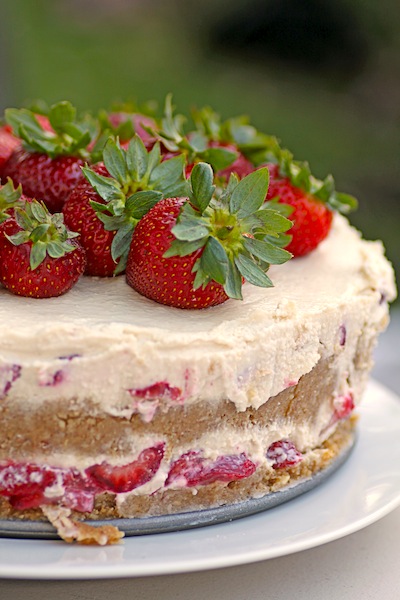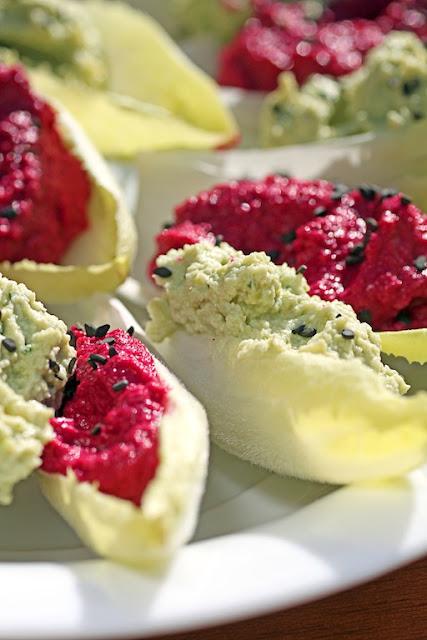One of my cookbooks, Big Small Plates, is organized by similar chapters: Sticks, Picks, and with Fingers; Dressed, Not Naked; Bowls and Spoons; On a Raft; Knife and Fork; and Something Sweet. In old diner lingo, if something came “on a raft,” it meant that the food was served up on toast. Our group stretched that concept to include buns, naan bread, baguette slices, graham crackers, jicama slices, endive and lettuce leaves, tortilla chips, tart shells, nut crusts, hollowed out orange halves, and melon slices.
Liege Waffles served as my rafts, carrying fresh cherries macerated in Catdaddy Carolina Moonshine. We got hooked on this particular spirit at New Orleans’ Cochon restaurant. It tastes like a smooth, sweet liqueur, with hints of vanilla, nutmeg and cinnamon, and it flavored the cherries beautifully.
Liege Waffles, originating from Liège, Belgium, are very special waffles. They were invented by the chef of the prince-bishop of Liège in the 18th century as an adaptation of brioche bread dough, resulting in a richer, denser, sweeter, and chewier waffle. When baked, chunks of pearl sugar partially melt on the inside of the waffle, and caramelize on the outside. Preparation is a two-day process, but the reward is well worth the effort. Toppings are optional, and really not necessary.
The Liege Waffle recipe I followed appears at the bottom of this post. But first, here are a few photos from the evening…
 |
| Drunken Cherries aboard a Liege Waffle Raft |
 |
| Sandra with one of Lauren’s S’mores |
 |
| Jack with one of Sandra’s amazing Pressed Cuban-style Burgers |
 |
| One of Pammy’s salads, incorporating jicama rafts |
| Jim feeding Bradley Lemon Tart |
| Bradley’s Naan bread rafts topped with grilled sausage and mozzarella |
?
 |
| Very important in our crowd |
?
 |
| Olivia scooping her homemade sorbet into orange rafts |
 |
| Jim and Sam |
| Jim and Sam’s Prosciutto slices holding on tight to cantaloupe rafts |
| Sliced baguette rafts carrying salami |
| Jack and John enjoying another “theme” of the evening |
| Two out of four pairs of white, gauze pants…the other theme of the evening. |
 |
| Men will be boys… |
 |
| Kai’s Veggie Lettuce Rafts |
??
 |
| Carmen’s Strawberry Shortcake sandwiched between raw nut-crust rafts |
 |
| Carmen’s Beet and Artichoke Hummus on endive rafts |
| Stars on the Water played “tropical” rock and roll |
Get a Waff included a recipe for liege waffles with the bag of sugar, but I was impressed by the recipe I found here. I intend on trying Get a Waff’s recipe, which does not require as much resting time or overnight refrigeration, and I’ll update this post when I do.
Liege Waffles
Slightly adapted and doubled from this recipe
Makes about 10 regular size, or 20 snack-size waffles
Ingredients:
3 teaspoons active dry yeast
1/2 cup scalded whole milk (110-115 F)
5 tablespoons water (110-115 F)
4 cups King Arthur bread flour
2 large eggs (room temperature egg, lightly beaten)
2 tablespoons light brown Muscovado sugar
1-1/2 teaspoons sea salt
16 tablespoons unsalted butter, at room temperature
2 tablespoons honey
1 tablespoon Pure Vanilla Bean Paste
1-1/2 cups Belgian Pearl Sugar
Preparation:
Place yeast, milk, and water into the bowl of an electric mixer, fitted with a paddle attachment. Stir for a few seconds to moisten the yeast.
Add the eggs and 1/3 of the total flour. Mix to blend. Scrape down sides of bowl.
Sprinkle the remaining flour over the mixture, but do not stir. Cover and let stand about 90 minutes (at the end of that time, you’ll notice the batter bubbling up through the cover of flour).
Add brown sugar and salt to the bowl, and mix on low speed to blend.
With machine on low, add the honey, vanilla, and butter, two tablespoons of butter at a time.
Increase speed to medium-low and continue mixing 4 minutes. Scrape down the sides once or twice during that period. Turn the mixer off and let the dough rest for 1 minute, and then continue to mix for 2 additional minutes. The dough should start sticking to the sides of the bowl during the last minute of mixing and, in the last 30 seconds of so, should start to ball-up on the paddle. If this does not happen, let the dough rest for 1 more minute and mix for another 2 minutes. Whatever the outcome of the extra mixing, proceed to the next step.
Scrape the dough into a large bowl, sprinkle lightly with flour, cover with plastic wrap, and let rise at room temperature for 4 hours. This step is crucial for developing the flavor.
Refrigerate the dough for 30 minutes before proceeding. This is essential to allow yeast respiration to slow.
Gently deflate the gases from the dough by pressing on it with a rubber spatula. Scrape the dough onto a large piece of plastic wrap, and then use the spatula to press the dough into a long rectangle. Fold that rectangle over on itself (by thirds like a letter) so that you have a square of dough. Wrap it in plastic, weigh it down with two heavy dinner plates on top of it, and refrigerate overnight. (Note: Since I doubled the recipe, I probably should have separated the dough into two pieces. I did have a slight explosion of dough through my plastic wrap during the refrigeration process).
The next day, place the cold, firm dough in a large bowl and add 1/2 of the pearl sugar. Mix the sugar into the dough by hand until the chunks are well-distributed. Add the remaining 1/2 of the sugar and do the same.
Divide the dough into 10 pieces of equal size (about 3.5 ounces or 100 grams). If making the smaller size, divide into 20 portions.
Shape each piece of dough into into an oval, cover loosely with plastic wrap, and let rise for 90 minutes.
Cooking temperatures of waffle irons vary, so this is where you’ll need to experiment. If you have a professional waffle iron, the waffles cook at 365-370 degrees F (the maximum temp before sugar begins to burn/decompose) for approximately 2 minutes.
If you have a regular waffle iron, heat the iron to 420 degrees F, place an oval of dough on the iron, close the iron, and immediately turn the temperature dial all the way down to prevent the sugar from burning.
I used a Waring Pro Waffle Iron, but also took advantage of our infrared thermometer to monitor the temperature. I found that setting the dial to “6” heated up the iron to 420 degrees. Once I put in the dough and closed the iron, I turned the dial down to “3” and cooked each waffle a tad over 2 minutes. You do want to see the caramelized sugar form on the outside, but not to the point of burning. I allowed the iron to heat back up between waffles. Again, you’ll need to experiment, but I had great results after playing with the first two.
Be very careful when removing the hot waffle from the iron, or you will be burned by the caramelized sugar. Transfer the hot waffles to a cooling rack and allow to cool briefly before serving. Although better warm, I made mine a few hours in advance, wrapped them in foil, and served them at room temperature. I don’t think I’ll ever go back to any other kind of waffle.
Denise & John







